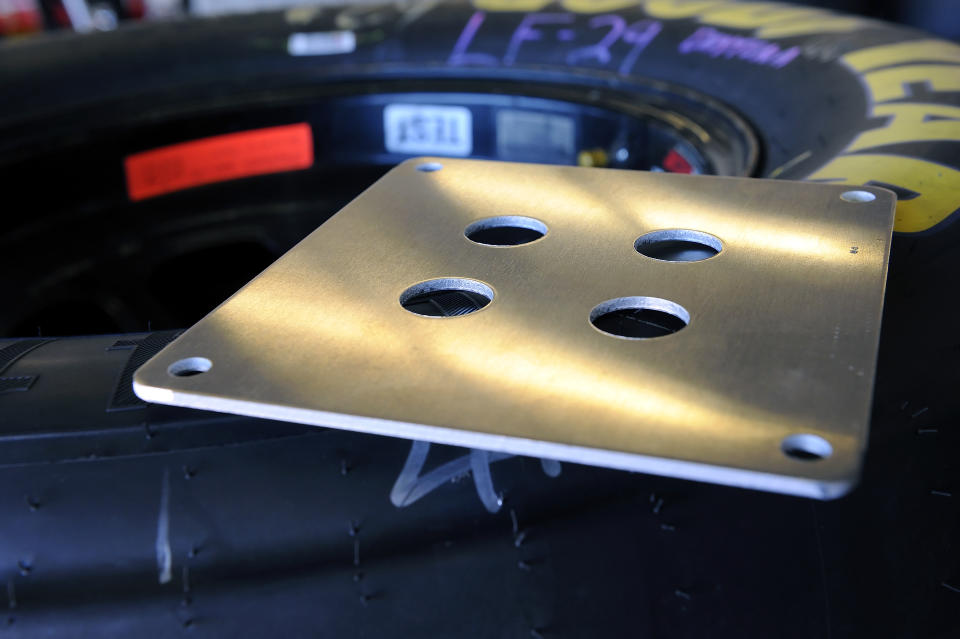The end of an era: Sunday's Daytona 500 is the last restrictor plate race
DAYTONA BEACH, Florida — It’s the end of the NASCAR restrictor plate world as we know it.
Sunday’s Daytona 500 marks the end of an era in modern NASCAR. Over 30 years after restrictor plates were put in the engines of Cup Series cars at Daytona and Talladega, Sunday will be the final race with restrictor plates. When NASCAR heads to Talladega later in the year and Daytona in July, the cars will have tapered spacers in the engines instead of restrictor plates.
“Tapered spaces are still restrictor plates,” Kyle Busch noted.
OK, so maybe the change from plates to spacers isn’t all that significant. But for longtime NASCAR fans, Sunday’s race is the end of an era.
NASCAR implemented restrictor plates in 1988 after a frightening crash involving Bobby Allison, who flew into the catchfence at Talladega in 1987. That year, Bill Elliott’s pole speed for the Daytona 500 was over 210 mph and he set the NASCAR record for fastest lap at Talladega a couple months later with a pole lap of 212.809 mph.
Allison took flight in that spring Talladega race. After his car blew a tire early in the race it flew into the fence near the start/finish line. Thankfully, the back end of Allison’s car hit the fence and he didn’t flip multiple times as he was entangled in the fencing.
NASCAR slowed the cars down for the final two races at Daytona and Talladega that season but did so with temporary measures. Plates were implemented for the 1988 Daytona 500 (won fittingly by Allison) and they worked in throttling the speed of the field. Ken Schrader’s pole speed didn’t break 194 MPH.
Plates work by limiting the airflow to an engine. The lack of airflow chokes down horsepower and prevents cars from accelerating anything close to how they would with full air intake.
While the plates were immediately successful in limiting the dangerous speeds teams were reaching at Daytona and Talladega, that’s not the only reason they’ve hung around so long. Since cars with plates couldn’t accelerate away from each other, the addition of restrictor plates created closer racing with bigger packs at Daytona and Talladega and heightened the importance of the draft. There’s a reason why the term “plate racing” makes you think of 30 cars lined up in a pack just feet away from each other.

It also didn’t hurt that a guy named Dale Earnhardt was exceptional at navigating the draft and excelling with restrictor plates. Earnhardt won 13 races at Daytona and Talladega. Only two of those victories came before NASCAR mandated the use of restrictor plates after Allison’s crash.
Three of Earnhardt’s final five victories came at Talladega, including his final win in the fall of 2000. That race, considered by many NASCAR fans to be the greatest final laps of Earnhardt’s career, saw Earnhardt go from 18th to first in the final five laps.
[Batter up: Join or create a 2019 Yahoo Fantasy Baseball league for free today]
Earnhardt’s drive was made possible by rules changes that NASCAR implemented earlier in that season after cries of boring racing during the Daytona 500. The series instituted a standard shock rule for the 2000 Daytona 500 that led to qualifying races that were snoozers and a Daytona 500 that featured the fewest lead changes (nine) since 1971.
In response to the complaints — led by Earnhardt — NASCAR made changes that included a wicker on the roofs of cars to help drivers pass easier with the aid of the draft. That Talladega race had 49 lead changes, the most in 11 years. Earnhardt wasn’t a fan of the changes either — he made sure to note that in victory lane — but there’s no denying he wouldn’t have been able to make that type of drive at Daytona earlier in the year.
The same rules setup was in place at Daytona in 2001 as the race featured 49 lead changes. Earnhardt was killed in a head-on crash with the wall on the final lap of the race. That November, NASCAR changed the rules (but kept the plates) for the 2002 races at Daytona and Talladega.
Sunday’s race is the final in the modern restrictor plate era as NASCAR is using tapered spacers to significantly choke down horsepower at all of its tracks in 2019 instead of limiting acceleration at just Daytona and Talladega. Instead of having 750 horsepower at all but the biggest tracks in NASCAR, teams will be using spacers in the engines that limit horsepower output to 550 at all 36 races. With a limited-horsepower setup in place across the board, there’s no need for NASCAR to specifically choke back horsepower at Daytona and Talladega.
If NASCAR wasn’t making those widespread rules changes this season, there’s a good chance the sanctioning body would be looking at ways to spice up the racing at Daytona and Talladega. Much like they were in 2000, Thursday night’s Duels were less than thrilling.
The qualifying races weren’t an outlier either. Sunday’s Clash featured a lot of single-file racing up in the high groove. So did the three plate races after the 2018 Daytona 500, a wild and wacky race that was won by Austin Dillon. While Earnhardt was able to slice his way through the field nearly 20 years ago for his final win, drivers are unable to do that with the way the cars have been engineered in this current restrictor plate configuration. And that leads to more pragmatism.
Drivers being pragmatic doesn’t put on a good show.
“It’s easier said than done because everyone is looking at it saying, ‘Man, if I pull out of line, doesn’t work, I’m going back to 20th, or in the 500 back to 35th,'” Joey Logano said. “I’m seventh or eighth right now, I don’t want to go back to 30th. You’re not willing to take that risk as much. That’s kind of what goes through all our minds.
“If I do it and it works, great. If it doesn’t, I’m way in the back, taking me forever to get back up, I probably won’t get back up.”
Maybe that ability to easily move through the field will change with the new rules that start in April. Maybe it won’t. No one will know for sure until race weekend begins at Talladega. But while restrictor plates are disappearing after this weekend, the “plate racing” you see at Daytona and Talladega isn’t going anywhere.
“It’s just a small part of what you see,” Denny Hamlin said. “Whether it be a plate or whatever, you’ll still see the same type of racing. [The plate] just won’t be there.”
– – – – – – –
Nick Bromberg is a writer for Yahoo Sports.
Follow @NickBromberg on Twitter
More from Yahoo Sports:
• PGA Tour pro defends paying caddie $5K on $1.3M win
• NFL bars NCAA’s all-time sack leader from combine
• Only one NBA team failed to scout Antetokounmpo
• Black History honor for Kaepernick sacked by lawmakers



